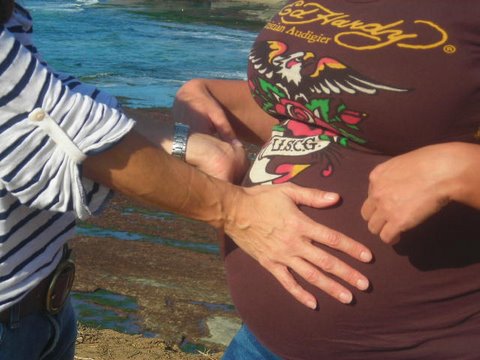
Surrogacy – A Love Story, Part Three
Hello friends. Here’s the third part of our new series by writer Kelly Weiss Rogondino, who is generously sharing her personal journey with us. Read on for a powerful and candid look at the effects of cancer and the challenges and rewards of surrogacy.
February –April, 2009
In order for the fertility doctors to move forward, we needed to take specific steps: first was a physical exam for Lisa, followed by a psychiatric evaluation for Lisa, me and my husband. Following the medical exam and psych evaluations, Lisa went through a mock cycle with the fertility drugs to make sure that her body responded like it was supposed to. A month later, we began the “real” cycle which included daily shots in the abdomen to stimulate egg growth for me, and progesterone patches and shots in the rear for Lisa, to stop her from ovulating and to thicken the lining of her uterus, and get it ready to “receive” my embryo(s).
Two weeks into our cycle, one of the nurses at the fertility clinic reminded me that they could not do the embryo transfer until we and Lisa had signed our surrogacy agreement*. I contacted the attorney whom we had previously retained to draft our agreement at the recommendation of a friend, to let him know the anticipated date of embryo transfer, and he advised me that it would take him several months to finish the agreement. But we only had 2-3 weeks! We immediately parted ways with him and retained a wonderful attorney recommended by the fertility clinic (and we had the (31 page) agreement in hand 3 days later).
We retained another attorney on Lisa’s behalf, to review the agreement with her as well before she signed. The agreement laid out payment plans to Lisa which corresponded to each phase of the pregnancy (we had to fund an escrow account for the full amount of Lisa’s fee and we had to take out a life insurance policy on Lisa’s behalf with her then 8 year old daughter as the beneficiary, in the event anything happened to Lisa during the surrogacy process). There were also issues and circumstances covered in the agreement that you wouldn’t necessarily have to predetermine if you were carrying your own child (for example, what happens to the unborn baby if my husband and I both die during Lisa’s pregnancy ? We had to name guardians); what happens if something is wrong with the baby in utero (whose decision is it to intervene and decide a course of action?) It was Lisa’s body but our child, so the potential for conflict over pregnancy related issues was very real.
[*as of January 1, 2013, CA Family Code Section 7962 (d) requires that the surrogacy agreement be signed prior to the surrogate starting injectable medications].
During the next two to three weeks, the surrogacy agreement was signed, the escrow account from which Lisa’s payments would be drawn was set up and funded by us, Lisa and I both had weekly doctor visits, ultrasounds and blood tests to make sure that everything was progressing as it should be. Lisa lives two hours from us and she was a trooper driving to/from Los Angeles every week for our appointments (which she continued to do once we were pregnant because my ob/gyn saw Lisa prenatally and delivered my baby). Lisa was attending school to be an ultrasound technician during this process, and we had a false alarm when Lisa volunteered to have an ultrasound in class and her instructor advised her that she thought she was going to ovulate (exactly what we didn’t want to happen)! Lisa called me and our fertility doctor, then drove to the fertility clinic stat for an exam. If she was indeed about to ovulate, we would have to scrap the month and start all over again (and pay for the medications again). It turns out that Lisa was not about to ovulate and I’m not sure what the instructor saw on the ultrasound, but it made for an interesting few hours, to say the least. This was just one of a few fire drills that we had along the way. I’m sure it goes with the territory of having a surrogate and parents who had never been through this process before, and we were all learning together as we went along…
My eggs were retrieved on April 15, 2009. Before I went under anesthesia, I heard a nurse telling the woman in recovery next to me, that they had retrieved 14 eggs from her. I didn’t know the significance of that number until I woke up from my procedure. I asked my husband how many eggs they retrieved, and he replied “four”. He said that I started crying and fell back to sleep, and proceeded to wake up, ask him the same question, cry when I heard the answer, and fall back to sleep, several more times. It turns out that when my hysterectomy was performed, the surgeon transposed my ovaries** in the event I ever needed radiation. As a result, the blood flow to the ovaries was reduced and therefore resulted in me only producing 4 retrievable eggs, despite the egg stimulating drugs that I used for 3 weeks. In addition, our fertility doctor had to go through my abdomen to retrieve the eggs, when the procedure is normally done vaginally. Of the 4 eggs retrieved, one was empty, and one didn’t fertilize normally, leaving only 2 viable embryos to transfer to Lisa’s uterus, which is what the fertility doctor did three days later, on April 18, 2009. Lisa was awake and it took all of five minutes. I saw the embryos in a microscope before the procedure, and held Lisa’s hand during the transfer. As we sat in the procedure room for the 10 minutes after transfer with Lisa’s legs elevated, Lisa was adamant that one of the embryos had “stuck”. She willed it so….
**Ovarian transposition is a surgical procedure in which the ovaries are displaced from the pelvis [in anticipation of] pelvic radiation therapy in order to maintain ovarian function.
Part Four coming soon, so be sure to check back regularly. Please feel free to share your own experiences below.






